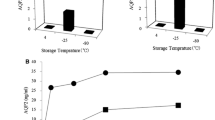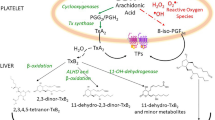Summary
Microalbuminuria is a predictor of persistent proteinuria, renal failure and cardiovascular disease and therefore accurate determination of urinary albumin concentration is important. We examined the stability of albumin in urine under different conditions of storage, temperature and sample preparation. There was no significant difference in urinary albumin concentration between fresh urine and urine stored at either 4°C or 20°C for up to 7 days. Similarly in urine samples from diabetic patients there was no significant difference in albumin concentration at levels ranging from 1.3 to 1999.3 mg/l between fresh urine at 4°C and urine stored frozen for 1 week, 1 month or 6 months. Neither storage temperature (−20°C or −40°C) nor centrifugation of sample prior to assay made a significant difference to the albumin concentration. Multiple freezing and thawing of urine samples during 6 weeks of storage at −20°C made no difference to albumin concentrations. Storage of urine samples in either polypropylene, polystyrene or borosilicate glass tubes did not result in a significant change in urinary albumin concentration after either 1 week or 1 month at −20°C although, after 1 month of storage, urinary albumin concentrations tended to be lower by an average of approximately 7%. In tubes to which gelatine had been added this was reduced to 4%. We conclude that fresh urine can be kept at 4°C or 20°C for up to 7 days. Frozen urine samples can be stored for up to 6 months before assay without any loss of albumin concentration. Polypropylene, polystyrene or borosilicate glass tubes are acceptable containers for short-term storage and samples can simply be thoroughly thawed and vortex mixed immediately prior to assay.
Similar content being viewed by others
References
Viberti GC, Hill RD, Jarrett RJ, Argyropoulos A, Mahmud U, Keen H (1982) Microalbuminuria as a predictor of clinical nephropathy in insulin-dependent diabetes mellitus. Lancet I: 1430–1432
Mathiesen ER, Oxenbøll B, Johansen K, Svendsen PA, Deckert T (1984) Incipient nephropathy in type 1 (insulin-dependent) diabetes. Diabetologia 26:406–410
Parving HH, Oxenbøll B, Svendsen PA, Christiansen JS, Andersen AR (1982) Early detection of patients at risk of developing diabetic nephropathy: a longitudinal study of urinary albumin excretion. Acta Endocrinol 100:500–505.
Mogensen CE, Christensen CK (1984) Predicting diabetic nephropathy in insulin-dependent patients. N Engl J Med 311:89–93
Messent JWC, Elliott TG, Hill RD, Jarrett RJ, Keen H, Viberti GC (1992) Prognostic significance of microalbuminuria in insulin-dependent diabetes mellitus: a twenty-three year follow-up study. Kidney Int 41:836–839
Jarrett RJ, Viberti GC, Argyropoulos A, Hill RD, Mahmud U, Murrel TJ (1984) Microalbuminuria predicts mortality in non-insulin dependent diabetes. Diabetic Med 1:17–19
Mogensen CE (1984) Microalbuminuria predicts clinical proteinuria and early mortality in maturity onset diabetes. N Engl J Med 310:356–360
Wiseman MJ, Viberti GC, Mackintosh D, Jarrett RJ, Keen H (1984) Glycaemia, arterial pressure and microalbuminuria in type 1 (insulin-dependent) diabetes mellitus. Diabetologia 26: 401–405.
Yudkin JS, Forrest RD, Jackson CA (1988) Microalbuminuria as predictor of vascular disease in non-diabetic subjects. Lancet II: 530–533
Mogensen CE (1982) Long-term hypertensive treatment inhibiting progression of diabetic nephropathy. BMJ 285:685–689
Feldt-Rasmussen B, Mathiesen ER, Deckert T (1986) Effect of two years of strict metabolic control on the progression of incipient nephropathy in insulin-dependent diabetes. Lancet I: 1300–1304
Silver A, Dawnay A, Landon J, Cattell WR (1986) Immunoassays for low concentrations of albumin in urine. Clin Chem 32: 1303–1306
Townsend JC (1986) A competitive immunoenzymometric assay for albumin in urine. Clin Chem 32:1372–1378
Townsend JC (1986) Effect of storage temperature on the precipitation of albumin from urine. Clin Chem 32:1986–1987
Silver AC, Dawnay A, Landon J (1987) Specimen preparation for assay of albumin in urine. Clin Chem 33:199–200 (Letter)
Townsend JC, Sadler WA, Shanks GM (1987) The effect of storage pH on the precipitation of proteins in deep frozen urine samples. Ann Clin Biochem 24:111–112
Townsend JC, Blair PJ, Forrest ARW (1988) Effect of storage pH on precipitation of albumin in urine from diabetics. Clin Chem 34:1355–1356 (Tech Brief)
Erman A, Rabinov M, Rosenfeld J (1988) Albumin determination in frozen urines-underestimated results. Clin Chim Acta 174:255–262
Osberg I, Chase P, Garg SK et al. (1990) Effects of storage time and temperature on measurement of small concentrations of albumin in urine. Clin Chem 36:1428–1430
Mohamed-Ali V, Southall F, Amin V, Gould M, Oragui E (1991) Effect of storage temperature on albumin content when measured by enzyme-linked immunosorbent assay (ELISA). Diabetologia 34 [Suppl 2]: A132 (Abstract)
Elving LD, Bakkeren AJM, Jansen MJH, de Kat Angelino CM, de Nobel E, van Munster PJJ (1989) Screening for microalbuminuria in patients with diabetes mellitus: frozen storage of urine samples decreases their albumin content. Clin Chem 35:308–310
Manley SE, Burton ME, Fisher KE, Cull CA, Turner RC (1992) Decreases in albumin/creatinine and N-acetylglucosaminidase/creatinine ratios in urine samples stored at −20°C. Clin Chem 38:2294–2299
Giampietro O, Cruschelli L, Penno G, Navalesi R, Clerico A (1991) More effects of storage time and temperature on measurement of small concentrations of albumin in urine. Clin Chem 37:591–592 (Letter)
Lamb E, Dawnay A (1989) The effects of sample preparation and storage on urine albumin determination. Ann Clin Biochem 26:560–562
Smith G, Wilcox AH, Barron JL (1987) More on determination of urinary albumin by centrifugal analysis. Clin Chem 33:1497
Keen H, Chlouverakis C (1963) An immunoassay method for urinary albumin at low concentration. Lancet II:913–916
Kearney EM, Mount JN, Watts GF, Slavin BM, Kind PRN (1987) Simple immunoturbidimetric method for determining urinary albumin at low concentrations using the Cobas Bio centrifugal analyser. Clin Path 40:465–468
Sorensen K (1991) Possible explanation for decrease in albumin content during storage of urine samples. Clin Chem 37:2013 (Letter)
Author information
Authors and Affiliations
Rights and permissions
About this article
Cite this article
Collins, A.C.G., Sethi, M., MacDonald, F.A. et al. Storage temperature and differing methods of sample preparation in the measurement of urinary albumin. Diabetologia 36, 993–997 (1993). https://doi.org/10.1007/BF02374489
Issue Date:
DOI: https://doi.org/10.1007/BF02374489




